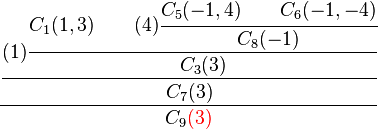RecycleUnits
In mathematical logic, proof compression by RecycleUnits[1] is a method for compressing propositional logic resolution proofs. Its main idea is to make use of intermediate (e.g. non input) proof results being unit clauses, i.e. clauses containing only one literal. Certain proof nodes can be replaced with the nodes representing these unit clauses. After this operation the obtained graph is transformed into a valid proof. The output proof is shorter than the original while being equivalent or stronger.
Algorithms
The algorithms treat resolution proofs as directed acyclic graphs, where each node is labeled by a clause and each node has either one or two predecessors called parents. If a node has two parents it is also labeled with a propositional variable called the pivot, which was used to compute the nodes clause using resolution.
The following algorithm describes the replacement of nodes.
It is assumed that in the resolution proof for all non leaf nodes with two parent nodes, the left parent node contains the positive and the right parent node the negative pivot variable.
The algorithm first iterates over all non leaf unit clauses and then over all non ancestor nodes of the proof. If the node's pivot element is the variable of the present unit clause's literal, one of the parent nodes can be replaced by the node corresponding to the unit clause. Because of the above assumption, if the literal is equal to the pivot, the left parent contains the literal and can be replaced by the unit clause node. If the literal is equal to the negation of the pivot the right parent is replaced.
1 function RecycleUnits(Proof): 2 Let
be the set of non leaf nodes representing unit clauses 3 for each
do 4 Mark the ancestors of u 5 for each unmarked
do 6 let
be the pivot variable of
7 let
be the literal contained in the clause of
8 if
then 9 replace the left parent of
with
10 else if
then 11 replace the right parent of
with
In general after execution of this function the proof won't be a legal proof anymore. The following algorithm takes the root node of a proof and constructs a legal proof out of it. The computation begins with recursively calls to the children nodes. In order to minimize the algorithm calls, it is beingt kept track of which nodes were already visited. Note that a resolution proof can be seen as a general directed acyclic graph as opposed to a tree. After the recursive call the clause of the present node is updated. While doing so four different cases can occur. The present pivot variable can occur in both, the left, the right or in none of the parent nodes. If it occurs in both parent nodes the clause is calculated as resolvent of the parent clauses. If it is not present in one of the parent nodes the clause of this parent can be copied. If it misses in both parents one has to choose heuristically.
1 function ReconstructProof(Node): 3 if
is visited return 4 mark
as visited 5 if
has no parents return 6 else if
has only one parent
then 7 ReconstructProof(
) 8
.Clause =
.Clause 9 else 10 let
be the left and
the right parent node 11 let
be the pivot variable used to compute
12 ReconstructProof(
) 13 ReconstructProof(
) 14 if
and
15
.Clause = Resolve(
,
,
) 16 else if
and
17
.Clause =
.Clause 18 delete reference to
19 else if
and
20
.Clause =
.Clause 21 delete reference to
22 else 23 let
and
//choose x heuristically 24
.Clause =
.Clause 25 delete reference to
Example
Consider the following resolution proof.
One intermediate result is  which is representing the unit clause (-1).
which is representing the unit clause (-1).

There is one non-ancestor node using the variable 1 as a pivot element:  .
.

The literal -1 is contained in the right parent of this node and therefore this parent is replaced by  . The string
. The string  denotes a reference to the clause
denotes a reference to the clause  (the structure is now a directed acyclic graph rather than a tree).
(the structure is now a directed acyclic graph rather than a tree).

This structure is not a legal proof anymore, because  is not the resolvent of
is not the resolvent of  and
and  . Therefore it has to be transformed into one again.
. Therefore it has to be transformed into one again.
The first step is to update  . As the pivot variable 1 appears in both parent nodes,
. As the pivot variable 1 appears in both parent nodes,  is computed as the resolvent of them.
is computed as the resolvent of them.

The left parent node of  does not contain the pivot variable and therefore the clause of this parent is copied into the clause of
does not contain the pivot variable and therefore the clause of this parent is copied into the clause of  . The link between
. The link between  and
and  is removed and since there are no other links to
is removed and since there are no other links to  this node can be deleted.
this node can be deleted.

Again the left parent of  does not contain the pivot variable and the same operation is performed as before.
does not contain the pivot variable and the same operation is performed as before.

Note: the reference  was replaced by the actual proof node
was replaced by the actual proof node  .
.
The result of this proof is the unit clause (3) which is a stronger result than the clause (3,5) of the original proof.
Notes
- ↑ Bar-Ilan, O.; Fuhrmann, O.; Hoory, S. ; Shacham, O. ; Strichman, O. Linear-time Reductions of Resolution Proofs. Hardware and Software: Verification and Testing, p. 114–128, Springer, 2011.
